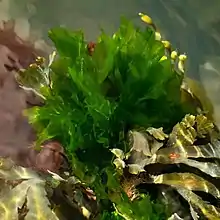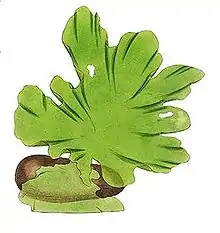Ulva lactuca
Ulva lactuca, also known by the common name sea lettuce, is an edible green alga in the family Ulvaceae. It is the type species of the genus Ulva. A synonym is U. fenestrata, referring to its "windowed" or "holed" appearance.[1]
| Ulva lactuca | |
|---|---|
 | |
| Ulva lactuca in Brofjorden, Sweden | |
 | |
| Illustration of Ulva lactuca in English Botany (Sowerby, 1790-1814) | |
| Scientific classification | |
| Phylum: | Chlorophyta |
| Class: | Ulvophyceae |
| Order: | Ulvales |
| Family: | Ulvaceae |
| Genus: | Ulva |
| Species: | U. lactuca |
| Binomial name | |
| Ulva lactuca | |
Description
Ulva lactuca is a thin flat green algae growing from a discoid holdfast. The margin is somewhat ruffled and often torn. It may reach 18 centimetres (7.1 in) or more in length, though generally much less, and up to 30 centimetres (12 in) across.[2] The membrane is two cells thick, soft and translucent, and grows attached, without a stipe, to rocks or other algae by a small disc-shaped holdfast.[3]
Green to dark green in colour, this species in the Chlorophyta is formed of two layers of cells irregularly arranged, as seen in cross-section. The chloroplast is cup-shaped in some references but as a parietal plate in others[3] with one to three pyrenoids. There are other species of Ulva which are similar and not always easy to differentiate.
Distribution
The distribution is worldwide: Europe, North America (west and east coasts), Central America, Caribbean Islands, South America, Africa, Indian Ocean Islands, South-west Asia, China, Pacific Islands, Australia and New Zealand.[3][4]
Ecology
Ulva lactuca is very common on rocks and on other algae in the littoral and sublittoral on shores all around the British Isles,[5] the coast of France,[6] the Low Countries[6] and up to Denmark.[7] It is particularly prolific in areas where nutrients are abundant.[8] This has been the case off the coast of Brittany where a high level of nitrates, from the intensive farming there, washes out to sea.[9][10] The result is that large quantities of Ulva lactuca are washed up on beaches, where their decay produces methane, hydrogen sulfide, and other gases.[9][11]
Certain environmental conditions can lead to the algae spreading over large areas. In August 2009, unprecedented levels of the algae washed up on the beaches of Brittany, France,[12][13] causing a major public health scare as it decomposed. The rotting thalli produced large quantities of hydrogen sulfide, a toxic gas which, like hydrogen cyanide, inhibits cytochrome c oxidase, inhibiting cellular respiration and resulting in critical cellular hypoxia. In one incident near Saint-Michel-en-Grève, a horse rider lost consciousness and his horse died after breathing the seaweed fumes. Environmentalists blamed the phenomenon on excessive use of fertilizers and the excretion of nitrates by pig and poultry farmers.[12] In an earlier separate incident at the same beach in July 2009, a truck driver had died near his vehicle after hauling three truckloads of sea lettuce without protective gear during the annual cleanup. Although initially recorded as a heart attack, the death of the truck driver prompted French authorities to exhume his remains for an autopsy. It was later determined to be cardiac arrest resulting from pulmonary edema, which is an indication of possible hydrogen sulfide poisoning.[10][14] Dead animals found on the algae-clogged beaches (including thirty-one wild boars in July 2011) were also claimed to be linked to toxic fumes by environmentalists.[15][16]
Life history
The sporangial and gametangial thalli are morphologically alike. The diploid adult plant produces haploid zoospores by meiosis, these settle and grow to form haploid male and female plants similar to the diploid plants. When these haploid plants release gametes they unite to produce the zygote which germinates, and grows to produce the diploid plant.[17][18][19]
References
- Bates, Colin. "An introduction to the (macro) algae of British Columbia". Electronic Atlas of the Flora of British Columbia, University of British Columbia. Retrieved 29 July 2020.
- "Ulva lactuca". Gettysburg College. Retrieved December 28, 2007.
- Burrows, E.M. (1991). Seaweeds of the British Isles. 2. London: Natural History Museum. ISBN 978-0-565-00981-6.
- "Ulva lactuca Linnaeus". AlgaeBase.
- Hardy, F.G.; Guiry, M.D. (2006). A Check-list and Atlas of the Seaweeds of Britain and Ireland. London: British Phycological Society. ISBN 978-3-906166-35-3.
- "Tisbe taxon details: Ulva lactuca Linnaeus, 1753". Flanders Marine Institute (VLIZ).
- Geertz-Hansen, O.; Sand-Jensen, K.; Hansen, D. F.; Christiansen, A. (September 1993). "Growth and grazing control of abundance of the marine macroalga, Ulva lactuca L. in a eutrophic Danish estuary". Aquatic Botany. 46 (2): 101–109. doi:10.1016/0304-3770(93)90039-Y.
- Michael Guiry. "Overview of Ulva lactuca ecology". The Seaweed Site. Retrieved December 28, 2007.
- Hirst, Michael (August 11, 2009). "Toxic seaweed clogs French coast". BBC News. Retrieved August 11, 2009.
- "Seaweed suspected in French death". BBC News. September 7, 2009. Retrieved 2009-09-08.
- Nedergaard, Rasmus I.; Risgaard-Petersen, Nils; Finster, Kai (August 17, 2002). "The importance of sulfate reduction associated with Ulva lactuca thalli during decomposition: a mesocosm experiment". Journal of Experimental Marine Biology and Ecology. 275 (1): 15–29. doi:10.1016/S0022-0981(02)00211-3.
- Hirst, Michael (2009-08-11). "Toxic seaweed clogs French coast". BBC. Retrieved 2009-08-11.
- Samuel, Henry (2009-08-11). "Almost 100 places in Brittany have toxic seaweed". Telegraph.co.uk. Retrieved 2009-08-11.
- Lymbery, Philip (2014). Farmageddon: The True Cost of Cheap Meat. Bloomsbury Publishing. p. 179. ISBN 9781408846421.
- Chrisafis, Angelique. "Brittany beaches hit by toxic algae". The Guardian (27 July 2011). Retrieved 31 December 2015.
- McKenna, Maryn (26 July 2011). "Attack of the Deadly Slime: Farm Effluent Ruins French Beaches". Wired. Retrieved 31 December 2015.
- Abbott, I.A. & Hollenberg, G.J. (1976). Marine Algae of California.. California: Stanford University Press. ISBN 978-0-8047-0867-8.
- Mondragon, J. & Mondragon, J. (2003). Seaweeds of the Pacific Coast.. Monterey, California: Sea Challengers. ISBN 978-0-930118-29-7.
- ""Plant Science 4 U". Retrieved 5 July 2016.
- Indergaad, M and Minsaas, J. 1991 in Guiry, M.D. and Blunden, G. 1991. Seaweed Resources in Europe: Uses and Potential. John Wiley & Sons ISBN 0 471 92947 6
- "Ulva Recipes". Monterey Bay Aquarium Research Institute. Archived from the original on January 2, 2008. Retrieved December 28, 2007.
Further reading
- Hayden, H.S., Blomster, J., Maggs, C.A., Silva, P.C., Stanhope, M.J. and Waaland, J.R. (2003) "Linnaeus was right all along: Ulva and Enteromorpha are not distinct genera" European Journal of Phycology 38: pp. 277–294, doi:10.1080/1364253031000136321